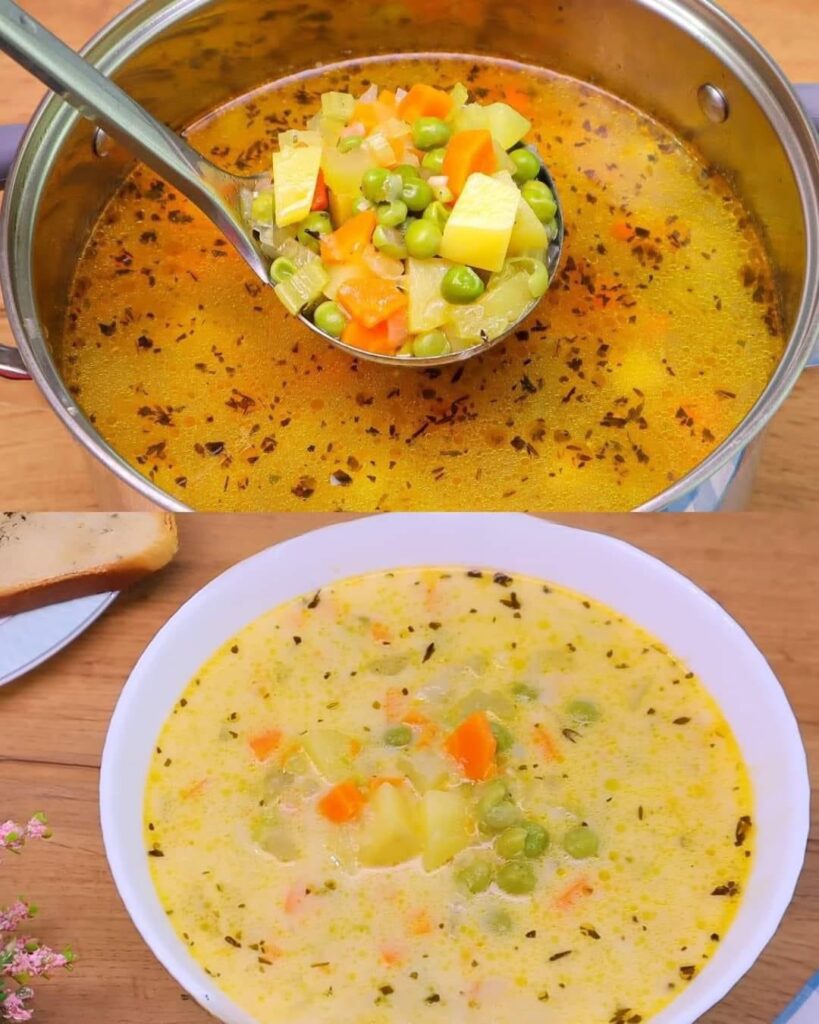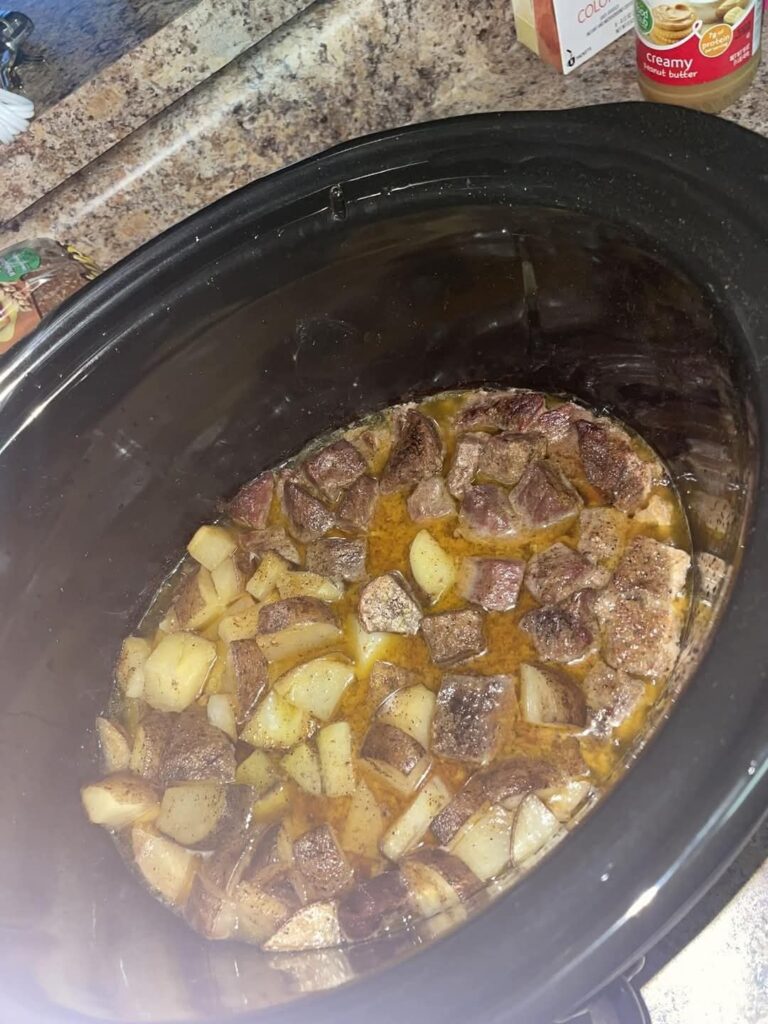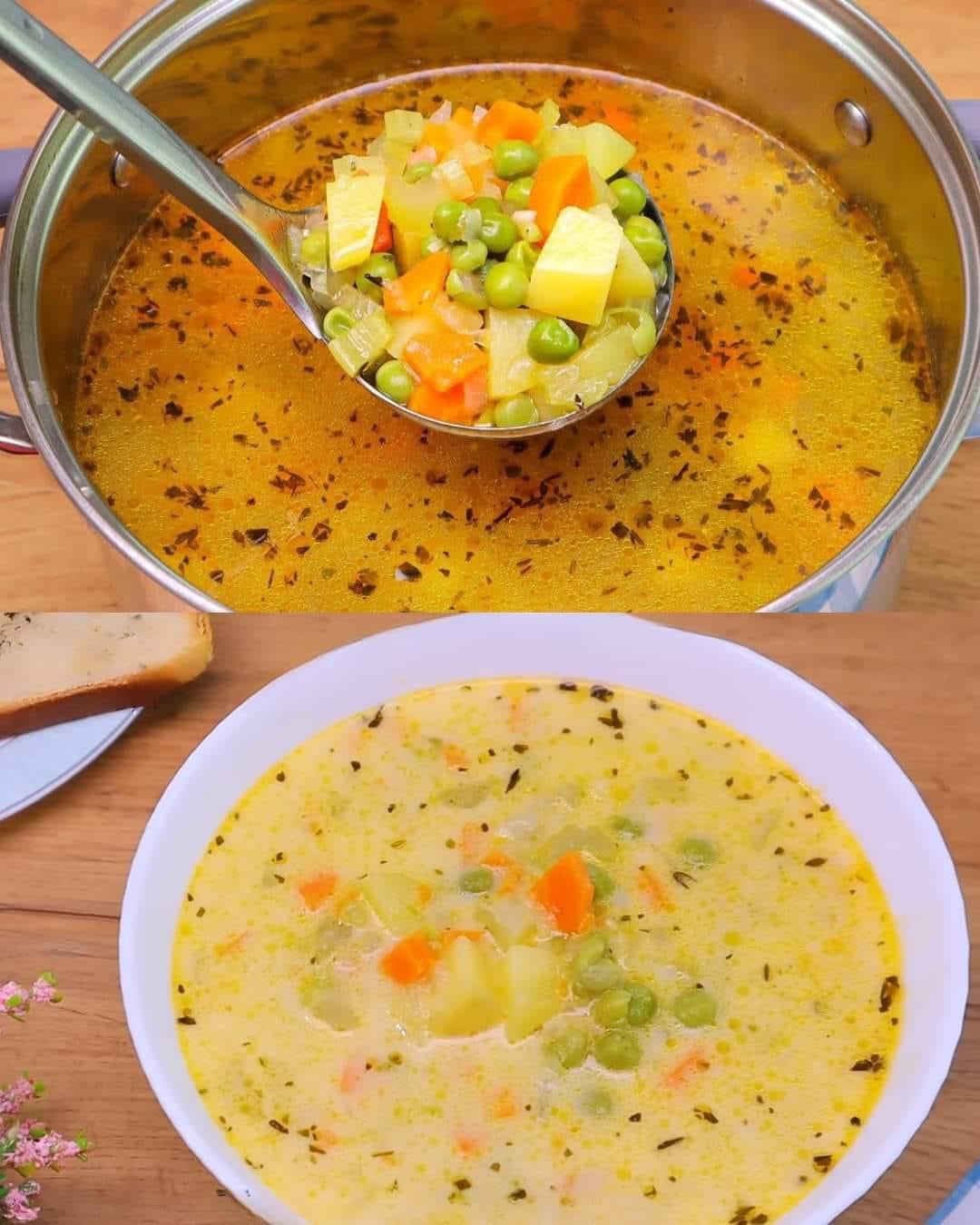
Ingredients:
- 3 onions, chopped
- 9 cloves of garlic, minced
- 6 carrots, diced
- 9 stalks of celery, chopped
- 6 potatoes, peeled and diced
- 1 kilogram (2.2 lbs) frozen peas
- 3 tablespoons olive oil
- 3 liters (12 cups) vegetable broth or water
- Salt and black pepper, to taste
- 1 teaspoon red pepper flakes (adjust to taste)
- 2 tablespoons dried oregano
- 1/2 teaspoon nutmeg
Instructions:
- Heat Olive Oil: In a large pot, heat the olive oil over medium heat.
- Sauté Vegetables: Add onions and garlic. Sauté until the onions are translucent and the garlic is fragrant, about 5 minutes.
- Add Carrots and Celery: Stir in the carrots and celery. Cook for another 5 minutes.
- Add Potatoes and Broth: Add the diced potatoes and vegetable broth (or water). Bring to a boil.
- Simmer: Reduce heat and let the soup simmer for about 15 minutes, or until the potatoes are tender.
- Add Peas: Stir in the frozen peas and cook for an additional 5 minutes.
- Season: Season with salt, black pepper, red pepper flakes, oregano, and nutmeg. Adjust to taste.
- Serve: Ladle the soup into bowls and serve hot
Ancient Roots
- Early Beginnings: The concept of vegetable soup likely dates back to ancient civilizations. The earliest versions were simple stews made by boiling vegetables and grains together in a pot over an open flame.
Medieval Europe
- Medieval Times: In medieval Europe, vegetable soups became a staple for both peasants and the wealthy. They often included a mix of available vegetables and herbs. The use of spices and herbs varied based on regional availability and social status.
Renaissance and Beyond
- Renaissance Influence: During the Renaissance, vegetable soups were refined with the introduction of new ingredients from the Americas, such as tomatoes and potatoes. This period saw a rise in more complex recipes and variations.
19th and 20th Centuries
- Modern Era: In the 19th and 20th centuries, vegetable soup recipes became standardized, and canned soups made them more accessible. The development of commercial soup brands in the early 20th century popularized vegetable soup globally.
Contemporary Trends
- Health Focus: Today, vegetable soup is often celebrated for its health benefits and versatility. It’s a popular choice in many diets due to its nutritional value and ability to be adapted to different tastes and dietary needs
Vegetable soup offers numerous health benefits, making it a nutritious choice for many. Here are some key benefits:
Nutritional Benefits
- Rich in Vitamins and Minerals: Vegetable soup is packed with essential vitamins (like A, C, and K) and minerals (such as potassium and magnesium) from the diverse vegetables used.
- High in Fiber: The vegetables provide dietary fiber, which aids in digestion and helps maintain a healthy gut.
- Low in Calories: Most vegetable soups are low in calories, making them a great option for weight management.
- Antioxidant Properties: Vegetables such as tomatoes and carrots are high in antioxidants, which can help combat oxidative stress and inflammation in the body.
Health Benefits
- Supports Immune Function: Ingredients like garlic and onions are known for their immune-boosting properties.
- Promotes Hydration: The high water content of soup helps keep you hydrated.
- Aids Digestion: The fiber in vegetable soup promotes healthy digestion and can help prevent constipation.
- Heart Health: Many vegetables used in soup, such as celery and carrots, are linked to improved heart health due to their low sodium and high potassium content.
Practical Benefits
- Versatile: You can adapt vegetable soup recipes to include a variety of vegetables based on what’s in season or on hand.
- Easy to Prepare: Vegetable soup is generally easy to make and can be a great way to use up leftover vegetables.
- Cost-Effective: Making soup at home can be more economical than buying pre-made versions.
- Freezable: Vegetable soup can be made in large batches and frozen, providing a quick and convenient meal option.
The nutritional profile of vegetable soup can vary depending on the specific ingredients and quantities used, but here is a general overview of the key nutrients typically found in a standard vegetable soup:
General Nutritional Breakdown (per 1-cup serving)
- Calories: 80-120 calories
- Protein: 2-4 grams
- Fat: 1-3 grams (mostly from olive oil or other fats used in cooking)
- Carbohydrates: 15-20 grams
- Fiber: 3-5 grams
- Sugars: 5-8 grams (natural sugars from vegetables)
- Sodium: 500-800 mg (varies widely based on added salt and broth)
- Potassium: 300-500 mg
Vitamins and Minerals
- Vitamin A: Found in high amounts from carrots and other orange or leafy vegetables.
- Vitamin C: Provided by vegetables like bell peppers and tomatoes.
- Vitamin K: Present in leafy greens like spinach or kale.
- Folate: Found in various vegetables, important for cell division and DNA synthesis.
- Iron: Present in small amounts, important for oxygen transport in the blood.
Healthier Variations
- Low Sodium: Use low-sodium broth or make your own broth to reduce sodium content.
- High Fiber: Adding beans or legumes can increase the fiber content.
- Low-Calorie: Opt for minimal oil or fats in preparation
Vegetable soup is loved by many for several reasons:
- Comforting and Nourishing: Its warm and hearty nature provides comfort, especially on cold days or when feeling under the weather.
- Health Benefits: People appreciate the nutritious qualities of vegetable soup, such as its high vitamin, mineral, and fiber content, which contribute to overall health.
- Versatility: The ability to adapt recipes based on seasonal vegetables and personal preferences makes it appealing to a wide audience.
- Ease of Preparation: Many find vegetable soup easy to make and a great way to use up leftovers or a variety of vegetables.
- Diet-Friendly: It fits well into various dietary plans, including vegetarian, vegan, and low-calorie diets
Vegetable soup is a versatile and nutritious dish that has been cherished across cultures for centuries. Its benefits include a rich array of vitamins, minerals, and fiber, while being generally low in calories and adaptable to various dietary needs. The soup’s comforting nature and ease of preparation further enhance its appeal, making it a popular choice for health-conscious individuals and families alike. Whether enjoyed as a hearty meal or a simple, wholesome starter, vegetable soup remains a staple in many kitchens due to its delicious taste and significant health benefits.
Overall, its combination of taste, health benefits, and versatility makes vegetable soup a favorite among many.
The exact nutritional content will depend on the specific vegetables and other ingredients used, but generally, vegetable soup is a nutrient-dense, low-calorie food that can support overall health and well-being.
Overall, vegetable soup is not only nutritious but also versatile, making it a great addition to a balanced diet.j
Throughout history, vegetable soup has evolved but remains a beloved comfort food that reflects the ingredients and culinary traditions of different cultures.
Enjoy your hearty, comforting vegetable soup!








